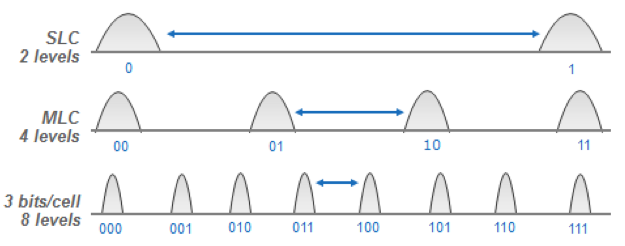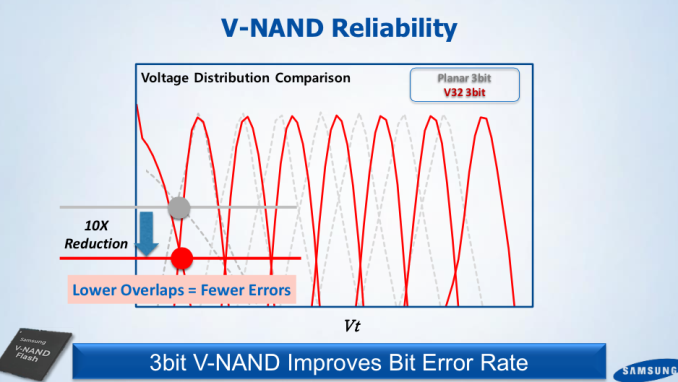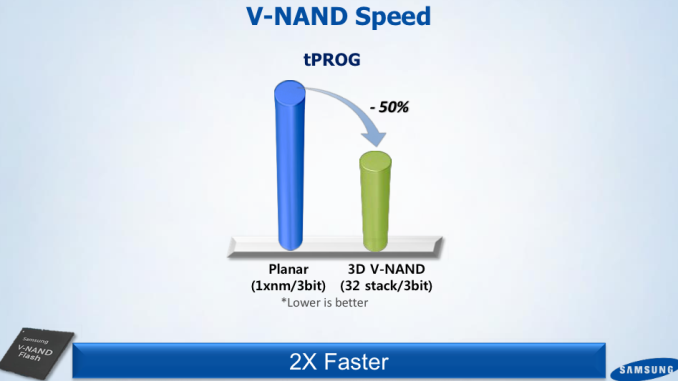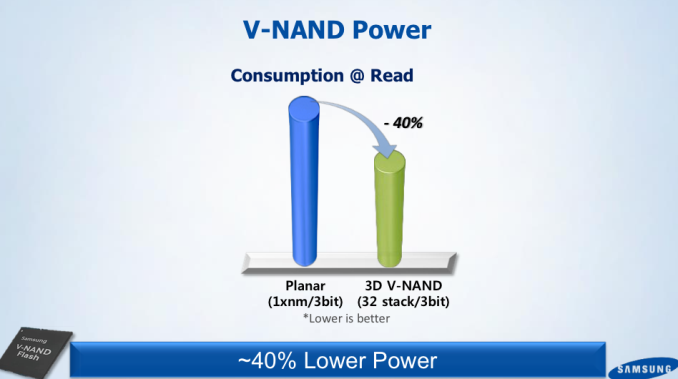Samsung SSD 850 EVO (120GB, 250GB, 500GB & 1TB) Review
by Kristian Vättö on December 8, 2014 10:00 AM ESTThree Bits and Three Dimensions: What's the Deal?
I've covered 3D NAND and TLC NAND in detail in the past and in this article I'll just explain what 3D technology means to TLC NAND and vice versa, so head over to the links above if you are in the search for a deeper analysis of the two technologies.
Truth to be told, 3D technology is ideal for TLC. The fundamental problem of TLC NAND has always been the limited endurance and performance, which is caused by the additional voltage states that are needed to store three bits (i.e. eight possible bit outputs) in one cell. With eight voltage states compared to four in MLC, TLC NAND is less resistant to wear out because it takes a smaller change in the cell charge to corrupt the cell value. Due to the way NAND works, the cells (or the insulators in the cell to be exact) wear out over time, which induces electron leakage that alters the cell charge and hence the voltage state. This gets worse with die shrinks because the number of electrons decreases, making the NAND even less tolerant to wear out.
The key aspect of 3D V-NAND is the process node. By going back to 40nm lithography, the number of electrons increase exponentially, which makes TLC a much more viable technology than it was with modern planar NAND. Obviously, V-NAND doesn't change the basics of TLC NAND because it still takes eight voltage states to differentiate all the possible 3-bit outputs, but thanks to the increased number of electrons there is more breathing room between the states and thus the cells are more error tolerant.
Samsung claims 10x reduction in voltage state overlaps, which is a massive change for the better. You can see how crammed the planar TLC voltage states are, so it's no wonder that the endurance is low because the states are practically overlapping at each point in the voltage distribution and hence even tiny changes in the cell voltage can alter the cell's voltage state.
The larger cell structure also enables higher performance because it takes less iterations to program a cell. With planar TLC NAND it took multiple very high voltage pulses as well as numerous verification process to reach the right charge, but with looser voltage distribution the programming process has less steps and thus takes less time.
And given the lower read/program latencies and less need for error correction, the power consumption is also considerably lower.
In addition to better latency and power consumption characteristics, Samsung claims doubled the density over its 19nm planar TLC NAND, but without knowing the die size of 128Gbit 32-layer TLC V-NAND, it's hard to say how accurate this is. There have been some whispering that the 128Gbit die would actually be identical to the 86Gbit MLC die because 86Gbit multiplied by 1.5 equals 129Gbit and at the silicon level MLC and TLC aren't any different, but for now that's just speculation.
What I do know is that Samsung started the mass production of TLC V-NAND later, which suggests that the two aren't completely uniform. Moreover, from what I know TLC NAND requires some changes to the peripheral circuitry in order to read three bits from one cell, so while the NAND memory arrays could be alike the die size is still likely at least slightly different. Anyway, we'll find out when Chipworks (or some other silicon analysis company) takes a closer look at the NAND die itself.















97 Comments
View All Comments
sylerner - Thursday, August 13, 2015 - link
The over-provisioning figures in the article are larger than the actual over-provisioning values.The source of error is failure to account for the flash memory used for TurboWrite.
The correct values are:
120GB: 10.6%
250GB, 500GB and 1TB: 8.0%
Lonerski - Sunday, January 31, 2016 - link
Did you use Rapid Mode in those benches ?CricDasher - Thursday, March 3, 2016 - link
Samsung SSD 850 Evo is a life-changer for anyone who uses it. With the sleek and beautiful build quality, Evo 850 does obviously come with a great price tag.There are of course different capacities of the given product, but I preferred to use the 120 GB version, largely due to the relatively low price and my actual need of owning an SSD.
My major requirement was to install the Operating System and few other mostly used applications inside the SSD, so that the whole computer looks so fast. Samsung Evo 850 120 GB SSD has done the job fantastically for me so far and I highly recommend this product to everyone.
Out of the sellers online, GearBest seems to offer the best package since GB is a trusted source of products. They are offering a flash sale at the moment and you may try it to get it for a relatively a low price.
http://www.gearbest.com/hdd-ssd/pp_311494.html?vip...
Budburnicus - Friday, March 11, 2016 - link
Samsung OWNS the SSD market! When I can buy an 850 EVO 500 GB model for just $110 and get for all intents and purposes, the BEST possible speed from a SATA 6 drive - there is REALLY NO POINT in buying ANY other brand!I mean the 850 EVO keeps up with, and sometimes even SURPASSES the 850 PRO - often in ways that will benefit the average power user/gamer more!
I wonder how much of that is due to the 6 GB of SLC write cache - as the 850 PRO series has no SLC NAND whatsoever!
Also, once the "Magical" storage capacity of 480 GB and above is reached, again, for JUST $110 - not only is that more than sufficient to hold my OS and all the games I play, but all SSDs tend to perform best at 480 GB and above, I would say for the 850 EVO series, this is DOUBLY TRUE! Due to the fact that the 500 GB model has a full 6 GB of SLC Turbo-write NAND (compared to 3 for the 250 and 120) - but it also has a full 512 MB of DDR3L on it!
I dunno why Anandtech has it listed as DDR2L memory, but it is indeed DDR3L RAM on ALL Samsung 850 series drives!
Tornadotuan - Friday, July 8, 2016 - link
Hi Hardware Community,I know this article is quite outdated right now, nevertheless the actual topic of the authors "Final Words" bug me right now. Especially now that enough time for longtime-endurance tests has passed.
Anyway, I can´t choose between the Samsung EVO 850 1TB v2 (289€) and die SanDisk Extreme 960GB (281€).
So pricewise the "Pro" is even cheaper right now compared to the Samsung. But there are some obvious differences:
- TLC 3D V-NAND vs. MLC Planar
- 5 years vs. 10 years warranty
- 150 TBW vs. 80 TBW
- higher Peak vs. consistency
- Samsung Bugging vs. sudden death drives
My usage:
- Client for everything: gaming, programming, office, multimedia - averything
- gonna split it in system and data-partition
- gonne be in laptop that´s used as desktop
- battery is wasted, so no concern about power consumption
So, usually I use hardware until it´s broken so meaning about 8-10 years.
Still I want steady performance without sudden decline in speed like with the EVO 840 :C
I´d be really glad, if you could tell me your opinion on this :)
Robbin1111 - Saturday, April 28, 2018 - link
Awesome drivers! Anyone has a code for this? I checked several sites, likehttps://www.retailmenot.com/coupons/samsung,
https://dealspure.com/Samsung-Electronics-Promo-Co...
but couldn't find one. My mom has an aging Dell D830, which is very slow and I'm looking for a reasonably priced replacement, and I think this driver is great.
rocky12345 - Thursday, January 30, 2020 - link
Yes this is a older review but just posting in 2020 on how my Samsung 850 EVO 500Gb has stood up to the wear & tear of every day computing. I have had my drive since 2015 in a computer that is on for many hours a day since I got the drive.The system gets used a lot so everything gets a really nice work out everyday. According to the Samsung software my drive is only at 2% of it's rated endurance lifespan. Not to bad for a drive that gets hit pretty hard everyday with reads and writes and to still have 98% life endurance left after all these years of use.
I read this review back in 2014 and it was one of the reasons I decided to get this drive for my system. I just came from a new write up form this site talking about a Midrive setup. What got me thinking about TLC nand was not the write up itself but a comment from a user and how they were saying just how bad QLC & TLC nand was and how they had low endurance lifespans.
Am I missing something here? My drive has TLC 3D V-nand made by Samsung and the drive is still at 98% endurance left on the SSD. Is Samsung's 3D V-nand better than regular TLC chips and lasts longer because of it. Yes my drive is getting up there in age and I plan on replacing it once I do a full system update and I will be getting a much faster NVMe PCI-e 4.0 drive.
As for the Samsung SSD I probably will use it to cache my 4 4TB hard drives since AMD has that caching setup in their platform and I can still find a good use for the Sata SSD I currently have. For now it is very snappy and the system feels very fast still with things such as Chrome or Firefox opening in half a second or Windows still booting up in a mere 7 seconds right after the bios post screen to the desktop so not worried about speed just quite yet.